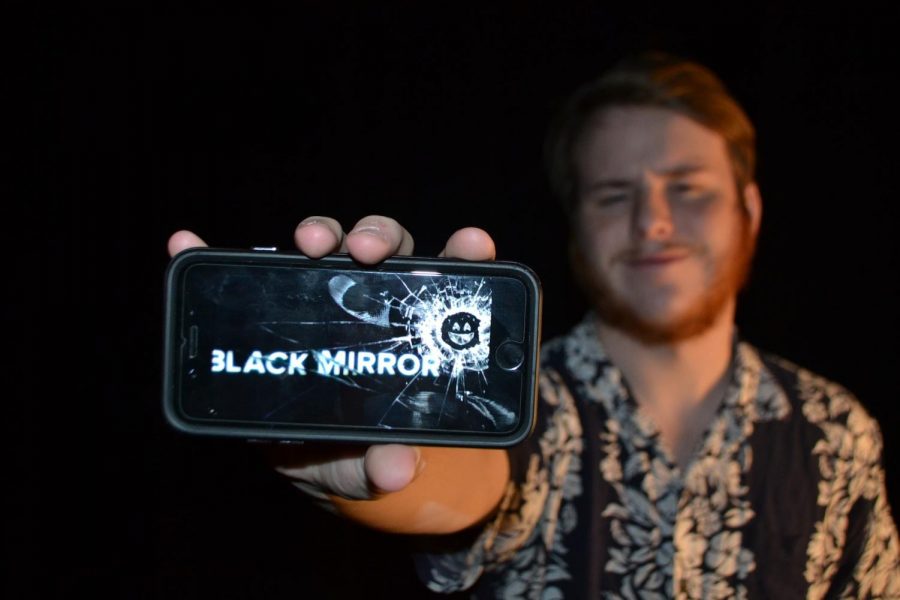Black Mirror season four gloriously shatters expectations
Netflix’s original series, Black Mirror, pleased and surprised fans with its just-released fourth season.
January 26, 2018
Netflix released the fourth season of its widely popular original series Black Mirror on December 29, 2017. Black Mirror initially gained a following for its thought-provoking stories and solidified a fanbase by continually delivering higher expectations for a Netflix original. The six episodes feel fresh and familiar to long time Black Mirror fans and will hopefully bring in a larger audience for the series.
Warning: Minor Spoilers
Season four of Black Mirror begins with the episode titled “USS Callister,” poking fun at the science fiction phenomenon of the 70s: Star Trek. The episode also offers a criticism of the overtly masculine themes and imagery found in American pop culture and media. Robert Daly, played by Jesse Plemmons, comes off as an innocent, under-appreciated “nice guy,” only to bring in the classic Black Mirror twist earlier than expected, as the audience learns Daly plays villain of this episode.
The latter half of the story shifts perspective from Daly, focusing on his fan-like underling Nannette Cole, played by Christina Milloti, who adores him. Daly presides as chief technical officer over a massively successful gaming company called Callister Inc., named in homage to the ship of the Black Mirror version of Star Trek, called Space Fleet. Callister’s flagship game called “Infinity” allows players to dive into a well developed, procedurally generated space simulator. Daly utilizes a used coffee lid to extract Cole’s DNA and creates an identical copy of Cole in a re-skinned version of Infinity modelled after Daly’s favorite show, Space Fleet. Cole-2 wakes up in the game and reacts with fury acting as a catalyst for the criticism the episode offers. Aesthetically, this episode presents a more colorful palette, reinforcing the more playful tone of the episode. Thematically, this episode tackles aspects of morality, such as what qualifies a good person, and also brings forth the thought of potential abuse faced by artificial intelligence.
In the second episode of the season called “Arkangel,” Marie Sambrell, portrayed by Rosemarie Dewitt, faces a challenge that all parents face: protecting their children in a scary world; and for Marie, her daughter, Sara. After a scare at a park, Marie signs Sara up for an experimental parental service called Arkangel. Through a neural implant, Marie obtains access to everything Sara sees and hears, as well as parental controls that allow her to block stressful events or interactions in Sara’s environment. This predictably desensitizes Sara to her world and blinds her to actual danger. The episode warns against overprotective parenting and the unintended consequences of our choices. The visual storytelling in this episode helped create an eerie sense of constant observation and successfully showed a large jump in time in only a few symbolic shots that worked together to translate the idea of the progression of time.
Filmed in Iceland, the third episode, “Crocodile,” turns the audience on its heads with an over the top cautionary tale about how far a lie can take you. Fifteen years ago on a drunken joyride with her boyfriend, Mia, played by Andrea Riseborough, helped cover up the vehicular manslaughter of a cyclist. Now a successful community architect, she will stop at nothing to keep her past buried. As the most visually dull episode of the season, the cinematography reinforces the themes and dreary context of the story. Iceland hosts a barren landscape both cold and unforgiving much like the nature of Mia’s lie. The details make this episode a sleeping masterpiece– the boring and predictable plot finds itself overshadowed by the intricacies of the background and seemingly insignificant dialogue that hauntingly brings the story full circle. One murder leads to another, which leads to another, and so on. The twist of this episode will not leave your jaw on the ground, but may induce sympathetic tears.
The fourth episode of the season, “Hang the DJ,” offers a breather for those who want a lighter, more inspiring story. The story follows Frank, wonderfully played by Joe Cole, and Amy, portrayed by Georgina Campbell, as they navigate through a dating service which puts them in a relationship for a predetermined amount of time. This episode explores the nature of human companionship and the idea that every new experience teaches a lesson. Subtly hinted at by the main characters themselves throughout the episode, the twist of the episode does not feel like a twist, but more like a well-earned reward.
“Metalhead,” the fifth episode of the season follows Bella, played by Maxine Peake, one of the survivors of an unexplained apocalypse as she fights for her survival in the face of a ruthless predatory artificial intelligence. Not much of this episode receives proper explanation and therein lies the beauty. The simple plot hides the grand message of humanism revealed at the end of the episode. Above all else, this episode excels in the visual aspect of storytelling. Presented in black and white in order to present a bleak future, each frame of the episode appears meticulously thought out and intercut with slow-motion footage, which adds layer upon layer of emotion into the story.
The final episode of the season could arguably serve as a series finale, as it encapsulates everything Black Mirror preaches into one episode. “Black Museum” first presents itself as a series of three separate stories told by Douglas Hodge’s character Rolo Haynes, the owner of the Black Museum, to his only visitor Nish, played by Letitia Wright . The anthology of stories at first seems separate, but as the episode closes, they tie together for the greatest reveal of the season.
Overall, this season successfully delivered a larger collection of box office worthy features than any season ever before.
The Chant’s Grade: A+




